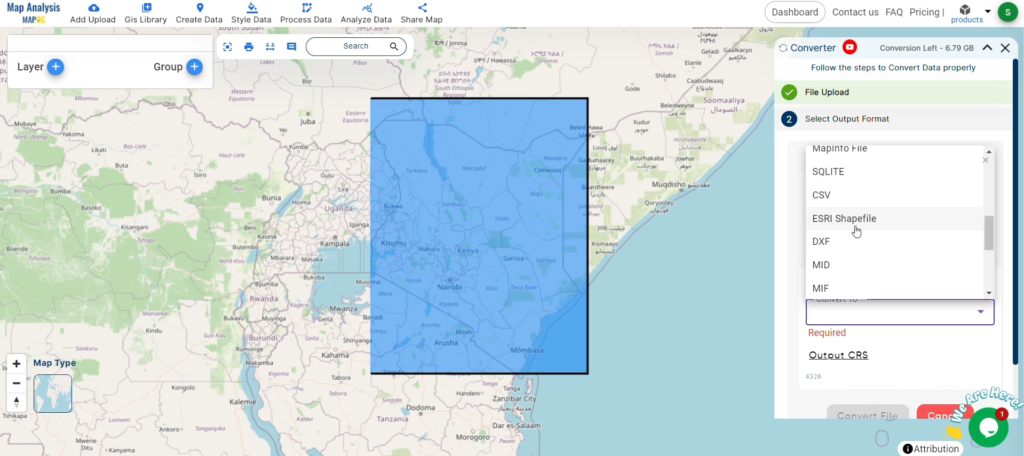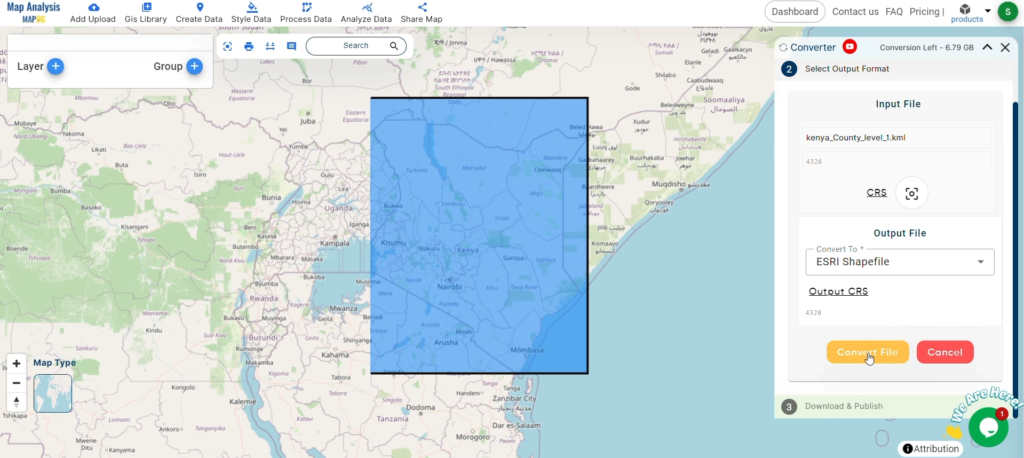GIS Data by MAPOG is an easy-to-use platform that provides access to a variety of GIS Data formats, including Shapefile, KML, and GeoJSON. Users may download rescue shelter data with ease because to its user-friendly interface, which makes it possible to map and analyse shelter sites globally in great detail. The platform streamlines the process of obtaining precise data, whether for resource allocation or emergency preparation.
How It Works
By offering detailed instructions, MAPOG simplifies the download of rescue shelter data. For smooth interaction with GIS tools, users can examine shelter data in multiple formats, including KML, SHP, MID, and more, with access to more than 200 nations and 900+ layers.
Download Rescue Shelters data of any countries
Note:
- All data is provided in GCS datum EPSG:4326 WGS84 CRS (Coordinate Reference System).
- Users need to log in to access and download their preferred data formats.
Step-by-Step Guide to Download Rescue Shelters Data
Step 1: Search for Rescue Shelters Data
To locate information about “rescue shelters“, use the search function. After choosing your preferred nation, examine data features such as polygons or points.

Step 2: Utilize the AI Tool
The “Try AI” feature simplifies searches. Enter the type of data you need and the location. The AI tool will fetch relevant results instantly.

Step 3: Refine with Filters
Use the filter option to narrow results by state or district. This ensures precision by focusing on specific regions, enhancing relevance for your project.

Step 4: Add Data to Map
Overlay the selected data onto the map using the “Add on Map” option. Add layers to a map for better visualization and analysis.

Step 5: Download the Data
Click “Download Data” and select either sample or full data. Choose from formats like Shapefile, KML, or any of the 15+ options. Agree to terms and conditions and complete the download.

Conclusion
Downloading rescue shelter data is quick and simple with GIS Data from MAPOG. Strategic planning and emergency response are only two of the many uses for its many formats and user-friendly features. With just a few simple steps, you may obtain precise shelter data and easily streamline your GIS applications.
With MAPOG’s versatile toolkit, you can effortlessly upload vector and upload Excel or CSV data, incorporate existing layers, perform polyline splitting, use the converter for various formats, calculate isochrones, and utilize the Export Tool.
For any questions or further assistance, feel free to reach out to us at support@mapog.com. We’re here to help you make the most of your GIS data.
Download Shapefile for the following:
- World Countries Shapefile
- Australia
- Argentina
- Austria
- Belgium
- Brazil
- Canada
- Denmark
- Fiji
- Finland
- Germany
- Greece
- India
- Indonesia
- Ireland
- Italy
- Japan
- Kenya
- Lebanon
- Madagascar
- Malaysia
- Mexico
- Mongolia
- Netherlands
- New Zealand
- Nigeria
- Papua New Guinea
- Philippines
- Poland
- Russia
- Singapore
- South Africa
- South Korea
- Spain
- Switzerland
- Tunisia
- United Kingdom Shapefile
- United States of America
- Vietnam
- Croatia
- Chile
- Norway
- Maldives
- Bhutan
- Colombia
- Libya
- Comoros
- Hungary
- Laos
- Estonia
- Iraq
- Portugal
- Azerbaijan
- Macedonia
- Romania
- Peru
- Marshall Islands
- Slovenia
- Nauru
- Guatemala
- El Salvador
- Afghanistan
- Cyprus
- Syria
- Slovakia
- Luxembourg
- Jordan
- Armenia
- Haiti And Dominican Republic
- Malta
- Djibouti
- East Timor
- Micronesia
- Morocco
- Liberia
- Kosovo
- Isle Of Man
- Paraguay
- Tokelau
- Palau
- Ile De Clipperton
- Mauritius
- Equatorial Guinea
- Tonga
- Myanmar
- Thailand
- New Caledonia
- Niger
- Nicaragua
- Pakistan
- Nepal
- Seychelles
- Democratic Republic of the Congo
- China
- Kenya
- Kyrgyzstan
- Bosnia Herzegovina
- Burkina Faso
- Canary Island
- Togo
- Israel And Palestine
- Algeria
- Suriname
- Angola
- Cape Verde
- Liechtenstein
- Taiwan
- Turkmenistan
- Tuvalu
- Ivory Coast
- Moldova
- Somalia
- Belize
- Swaziland
- Solomon Islands
- North Korea
- Sao Tome And Principe
- Guyana
- Serbia
- Senegal And Gambia
- Faroe Islands
- Guernsey Jersey
- Monaco
- Tajikistan
- Pitcairn
Disclaimer : The GIS data provided for download in this article was initially sourced from OpenStreetMap (OSM) and further modified to enhance its usability. Please note that the original data is licensed under the Open Database License (ODbL) by the OpenStreetMap contributors. While modifications have been made to improve the data, any use, redistribution, or modification of this data must comply with the ODbL license terms. For more information on the ODbL, please visit OpenStreetMap’s License Page.
Here are some blogs you might be interested in:
- Download Airport data in Shapefile, KML , MIf +15 GIS format – Filter and download
- Download Bank Data in Shapefile, KML, GeoJSON, and More – Filter and Download
- Download Railway data in Shapefile, KML, GeojSON +15 GIS format
- Download Farmland Data in Shapefile, KML, GeoJSON, and More – Filter and Download
- Download Pharmacy Data in Shapefile, KML, GeoJSON, and More – Filter and Download











